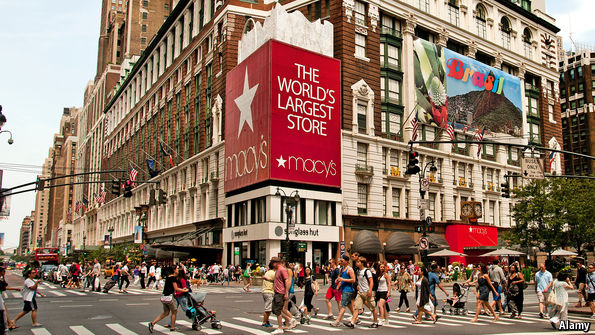Franchising, retail, business

07/01/2016
MACY'S, an American department store, announced results on January 6th it euphemistically described as "disappointing." The company plans to cut thousands of jobs and close 40 of its 770-odd shops. It is not the only American retailer in a slump.
“Black Friday”, America’s much-vaunted shopping day after Thanksgiving, has lost its buzz. Consumer confidence is wobbly. But two American “off-price” retailers, TJX and Ross, are thriving. Last year the Dow Jones United States Apparel Retailers Index dropped by 6%. The shares of Ross and TJX rose by 15% and 4%, respectively. So why are these "off-price" retailers trouncing the competition?
Traditional American retailers have several problems, many of their own making. Since the financial crisis they have lured shoppers with steady discounts. Margins have suffered accordingly. One company, JCPenney, tried to limit discounts in 2012, only to see shoppers revolt. Furthermore, department stores’ model—buying clothes from vendors months before those clothes arrive in shops—looks increasingly slow. Trends seem to move more quickly and weather patterns are becoming less predictable. This autumn, for example, Macy’s and other stores stocked the usual coats and scarves, but warm weather kept shoppers from paying out and bundling up.
As traditional retailers falter, off-price retailers are zipping ahead. Their basic model is as follows: when designers make more clothes than normal shops will sell at full price, TJX and Ross buy them at a deep discount, then resell them. The off-price retailers are thriving for many of the same reasons traditional retailers are not. Fast-moving trends, stingy consumers and even global warming are making it harder for shops to predict which clothes will sell at what price. As forecasts become less accurate, there are more clothes available for TJX and Ross to buy at a discount. On top of this, they do not share traditional retail’s biggest headaches. Consumers’ obsession with sales does not hurt them, because TJX and Ross offer brand-name clothes at a bargain each day. And online competitors are less threatening: shops have a constantly changing assortment, so consumers like coming to stores to hunt for deals.
Ross has become the single largest clothing shop in America, according to Euromonitor. TJX has a collection of smaller shops, such as TJ Maxx and Marshalls, which collectively have an even bigger footprint. In 2014 TJX reached a symboblic milestone: its revenue surpassed that of Macy’s.
Fonte:http://www.economist.com/blogs/economist-explains/2016/01/economist-explains-4?fsrc=scn/tw/te/bl/ee/st/whyoffpriceretailersaretrouncingdepartmentstores